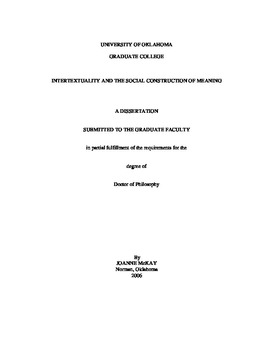| dc.contributor.advisor | Beach, Sara A., | en_US |
| dc.contributor.author | Mckay, Joanne. | en_US |
| dc.date.accessioned | 2013-08-16T12:20:07Z | |
| dc.date.available | 2013-08-16T12:20:07Z | |
| dc.date.issued | 2006 | en_US |
| dc.identifier.uri | https://hdl.handle.net/11244/1022 | |
| dc.description.abstract | The purpose of this study was to examine intertextual links made by second grade students during a variety of reading experiences and how they create meaning through those links. The guiding questions for the study are: What kinds of intertextual links do children make during classroom reading experiences? What links are acknowledged, and therefore, contribute to the meaning-making process? What links are disregarded? Why are they disregarded? | en_US |
| dc.description.abstract | Students made spontaneous links as well as prompted links. Spontaneous links were those connections made without directly questioning or instruction to do so, while prompted links were those made after direct questioning. The students also used a variety of text sources when making links: these were media and personal sources. Media included books, television shows, movies, video games, computer games, and songs. Personal source texts included their background knowledge as well as their experiences. Implications discussed include reading ability and comprehension issues as well as ways to foster intextual linking as a way children understand and respond to texts. | en_US |
| dc.description.abstract | This study was a qualitative, naturalistic inquiry into intertextuality in the context of classroom experiences. Six focal children were chosen for this study, two of whom were identified as above level readers, two of whom were identified as on-level readers, and two of whom were identified as below-level readers by their teacher. These students were observed in the context of classroom reading experiences and were interviewed individually about their experiences. The data sources for this study included a sociogram of class relationships, field notes on classroom reading experiences, and audio-taping individual student interviews following reading experiences. Reading experiences included Teacher readalouds, partner reading, popcorn reading, guided reading and independent reading. The children read or were read, picture books, chapter books, informational storybooks, and information books. Some findings included that below-level readers in this study were able to create intertextual links related to familiar characters and personal experiences: These students often had difficulty decoding the assigned text on their own, but worked actively to listen to the teacher, classmates and used their own logic and personal experiences when completing assignments related to classroom reading experiences. Classroom discussions and group partners were an important source for these children to "read" their environment and create meaning from text. On-level readers sometimes needed help with decoding text from the chapter books read, but were creating intertextual links based on character, plot, and literary elements such as point of view and author's writing style. These students were sophisticated at times when considering character's thoughts and motives. The above level readers were proficient in reading classroom books as well as expressing a favorite genre to read for pleasure. During interviews, however, it took a while to get these students to go beyond literal, factual interpretation of the text and to express their own views. | en_US |
| dc.format.extent | vii, 132 leaves : | en_US |
| dc.subject | Second grade (Education) | en_US |
| dc.subject | Intertextuality. | en_US |
| dc.subject | Education, Reading. | en_US |
| dc.subject | Education, Language and Literature. | en_US |
| dc.subject | Education, Elementary. | en_US |
| dc.subject | Reading (Primary) | en_US |
| dc.title | Intertextuality and the social construction of meaning. | en_US |
| dc.type | Thesis | en_US |
| dc.thesis.degree | Ph.D. | en_US |
| dc.thesis.degreeDiscipline | Department of Instructional Leadership and Academic Curriculum | en_US |
| dc.note | Adviser: Sara A. Beach. | en_US |
| dc.note | Source: Dissertation Abstracts International, Volume: 67-03, Section: A, page: 0873. | en_US |
| ou.identifier | (UMI)AAI3211360 | en_US |
| ou.group | Jeannine Rainbolt College of Education::Department of Instructional Leadership and Academic Curriculum | |
